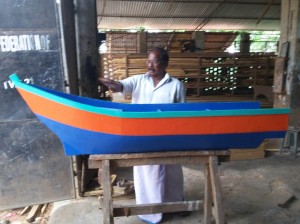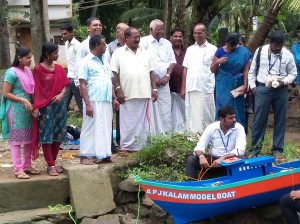IEEE Artisanal Deep Sea Fishers SIGHT is promoted by ADSGAF with the main objective of develop ideas, concepts, projects and products with the help of existing scientific know-how, managerial efficacy and engineering expertise and along with the traditional knowledge of fishermen.
IEEE ADSF SIGHT has gained steam in 2015 with multiple meetings and inauguration of work. A first members meeting was held in Nagercoil on 29 March 2015. The meeting was organised to brief about the prime motives behind the formation of the SIGHT to the members and to form a steering committee to kick start the activities officially with the formal plan for one year.
The inauguration of IEEE Artisanal Deep Sea Fishers SIGHT was held on 16 May 2015 by Shri. Satish Babu, Director-ICFOSS.
Click to read the IEEE ADSF SIGHT Inaguration report with photos.
The Project: Technology adoption for Vulnerability Reduction in Fishing
The Need:
Fishing at sea is probably the most dangerous occupation in the world, according to the International Labour Organization (ILO). The annual death toll among fishermen, estimated at 24,000 worldwide by the ILO. With more than 70 fatalities per day, fishing at sea may be the most dangerous occupation in the world, according to a new report released by the UN Food and Agriculture Organization (FAO). The safety of fishing vessels and fishers involves several interrelated components, such as the design, construction and equipment of vessels. On fishing boats, particularly small vessels, crews have to work at sea, on deck in all weathers, frequently with hatches open, in order to locate, harvest and preserve their catch. Working conditions in the boats are poor especially the night lightings in the boats and that increase the strain of the crew on board.
A lost vessel and a lost fisherman have a vital impact on the coastal community. The consequences of loss of life fall heavily on the dependants. In many developing countries, these consequences can be devastating. Widows often have a low social standing, and where there is no welfare state to support families and no alternative source of income, widows and their children may face destitution. The women fish vendors are suffering a lot for transporting their fish from place to place because lack of transporting facilities. They also need to pay extra amount to buy small pieces of ice to preserve the fish because there is no retail sales of ice in the villages.
Marine fisheries are contributing to the food security of the country by providing cheap and accessible protein to the mass. Due to the poor infrastructure facilities in fish landing centers, fishing harbors and fish markets, there are heavy post harvest losses in this sector. Post-harvest fish losses are a major concern and occur in most fish distribution chains throughout the world. Not only do losses constitute lost income to fishers, processors and traders but they also contribute to food insecurity – a loss of fish means less fish available for the consumer.
There is about 4 million fisherfolk population comprising in 864,550 families living in 3,288 marine fishing villages with a coastline of 8,129 km. The total fleet size of 1,94,490 crafts comprising 72,559 (37.3%), mechanized crafts, 71,313 (36.7%t) motorized crafts and 50,618 (26%) non-mechanized crafts (CMFRI 2010). Boat and boat, boat and ship collisions are very common. There is no effective communication system for the fisher people to communicate when they are in distress. There is no proper fishing vessel monitoring and controlling system in our country. Search and rescue of man missing and missing boats at sea mechanism is also poor.
The above said issues are need for a comprehensive package for reaching out for concrete and practical solutions which are imminent and necessary. With this backdrop, a multi faceted project is being envisaged with the provision of improved infrastructure facilities in fisheries for enhancing the livelihood of people who dependent on fishing, minimizing their vulnerability and protection of their lives. This project will bring in deep relationship and solidarity between a developed nation and a developing nation which will be fostered through the joint venture.
The Solution
The existing and proven technologies should be streamlined to monitor the voyage of boats, vessels, ships etc. Timely information on safety at sea relating to the head-on-collision with other boats and ships, communication to the shore with economical electronic gadgets, alert systems to locate missing fishermen due to accidents are important components in this subject. Direct communication systems should be developed by scientific organizations for accessing warning signals, fish location signals on a routine basis for the benefit of fishing vessels and fishers. As of today the role of Information and Communication Technology (ICT) in fisheries is very minimal in India, but the scope of the application and usage of ICT are very vast and could turn out to be the solutions for many present day issues of fishermen like emergency rescue, safety of the fishing boats, identification of fishing grounds and e-fisheries etc. Development and improvement of the infrastructure such as modernizing Fishing Harbors, Fish Landing Centers and also to actively intervene to minimize post harvest loses and also intervene in the strengthening of Post Harvest Infrastructure such as developing fish preservation & storage and cold-chain. Women fishers are the marginalized and it is a need to be protected them with suitable measures.
Project Component-1
Develop Safe Boat Design and Boat Building (SBDBB) based on FAO Standards: Boat building is a complex and labour intensive industry. Safety of the boat is based on the designing of the boat and use of quality materials in building boats. The base for width, draft and depth of the boat is related with the length of the boat. Optimum use of space in the boat is another safety factor to be considered while designing and building a boat. Marine electrification with proper luminous is indispensable in the boat.
The first consultation was held in July 2015 and recommendations were released. Click here to read the Safe Boat Building Consultation Proceedings and Recommendations
ADSGAF also held an orientation program for the IEEE SIGHT project on 19 September 2015 in Nagercoil. A celebration day was then held on 9 October 2015.
Now students are proceeding to engage in boat building activities. See below for photos.
Project component 2
Develop a Fishing Vessel Monitoring and Control System (FVMCS): Develop a system to monitor the number of boats operating from each fishing harbor and fishing landing centers. This will enable us to know their area of operation and enable us to know in advance the expected time of departure (ETD) and expected time of Arrival (ETA) of boats. This will avoid boat and boat, boat and ship collisions and other accident at sea. The system will help us to locate the missing boats and easy to engage in search and rescue operation. The system will also pave the way for minimizing the traffic pressure of boats at fishing harbors and at fish landing centers. Provide a cost effective communication system to the boats that will help them for better communication.
Project Component-3
Solar Powered Self Transportation (SPST) for Women Fish Vendors: Fabricate specially designed three wheeler vehicles which will be operate in solar power with a capacity of carrying 3 person and their 250 kilograms of fish. They need not wait for bus and they also will reach at the destination on time. The project team will support selected women for getting proper training on three wheeler driving and also assist them to obtain license. Initially they will make two such vehicles and based on the performance and acceptance from the target groups, the number vehicles will be increased. Women Self Help Groups can buy vehicles and engage in to the business.
Project Component-4
Solar Powered Small Ice Making Unit (SPSIMU) for Women Fish Vendors: The SPSIMU will produce 20 kg ice blocks with a maximum of 320 kg to 400 kg per harvest. The specialty of the unit is, it can operate in the house and can handle by a single woman. After her need the balance ice can be sold to other fish vending women who need ice. They need not depend on the big block ice manufacturers. Since the unit will run in solar power there will not be bother about the electricity charges. This best suitable for Self Help Groups and Joint Liability Groups. The project team will make one unit at first and based on the performance and demand the number of units will be increased.
Project Component-5
Infrastructure Assessment in Fishing Harbors and Fish Landing Centers (IAFHFLC): The project team will make a detailed study in two selected fishing harbors in Kanyakumari District and prepare detailed project proposal to improve the working condition and to provide green environment. The Project team will also identify the major reasons for post harvest losses and they will suggest how to minimize the losses.














